H12-261 : HCIE-R&S (Written) (Huawei Certified Internetwork Expert-Routing & Switching) : Part 11
-
Which of the following statements regarding a TCP sliding window are false?
- The sender advertises the size of the initial window.
- If the sender does not receive an acknowledgment message after the retransmission timer times out, it retransmits the unacknowledged data.
- The sliding window size can only be increased or remains unchanged.
- A TCP sliding window allows the sender to send multiple data packets before receiving an acknowledgment message.
- The sender does not need to transmit packets with a complete window size.
-
When DLDP detects a unidirectional fiber link, Huawei devices perform the following operations by default: The DLDP state machine changes to the Disable state; a trap is generated; the interface is automatically blocked.
- TRUE
- FALSE
-
Inter-device link aggregation implements reliable transmission of data traffic and mutual backup for stack member switches. However, the bandwidth of stack cables between stacked devices is limited. Which of the following methods can be used to improve forwarding efficiency?
- Configure the system MAC address switchover for the stack
- Use a stack card to connect the devices to be stacked
- Enable the function of preferentially forwarding local traffic
- Enable multi-active detection (MAD) for the stack
-
Why does RSTP achieve faster convergence than STP?
- RSTP convergence is not based on the timer mechanism
- RSTP has a smaller cost value
- RSTP has additional port states
- RSTP has a smaller timer value
-
Which of the following statements regarding the processing of BPDUs in 802.1w and 802.1D is true?
- In 802.1D, the bridge only forwards the BPDUs received from the root bridge
- In 802.1w, the bridge only forwards the BPDUs received from the root bridge
- In 802.1D, the bridge does not forward BPDUs
- In 802.1w, the bridge does not forward BPDUs
-
Two routers are connected through serial interfaces, but they cannot ping each other. The following information is displayed when you check the status of the connected interfaces:
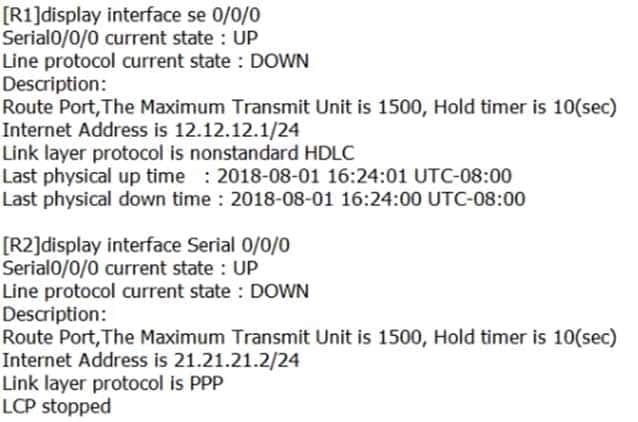
H12-261 HCIE-R&S (Written) (Huawei Certified Internetwork Expert-Routing & Switching) Part 11 Q06 037 Given this information, why are the two routers unable to ping each other?
- The subnet masks of the two interfaces do not match
- The IP addresses of the two interfaces are not on the same network segment
- The link layer protocols of the two interfaces are inconsistent
- The link bandwidth is insufficient
-
Which of the following statements regarding BGP route filtering is false?
- The relationship between the nodes of a route-policy is “OR.” That is, a route matches the routing policy as long as it is allowed by one node.
- On the same node of a routing policy, the relationship among multiple if-match clauses for different attributes is “OR.”
- After a route from a BGP peer is received and a routing policy is executed to filter out unnecessary BGP routes, these routes will not be added to the local BGP routing table.
- When a routing policy is configured for locally advertised routes, this policy takes effect before the routes are added to the BGP routing table.
-
Which of the following statements regarding route-policies are true?
- If more than one node is defined in a route-policy, the matching mode of at least one node must be permit
- An advanced ACL can be used in a route-policy to filter routes
- A route-policy can filter only default routes
- If the entry permit :: 0 less-equal 128 is defined, all IPv6 routes are permitted
-
Which of the following statements regarding BGP route reflectors (RRs) are true?
- If no RR is available, IBGP peers must be fully meshed. If an RR is available, IBGP peers do not need to be fully meshed
- An RR can advertise routes learned from a client to the other clients and non-clients
- An RR can advertise routes learned from IBGP peers to all clients and non-clients
- An RR can advertise routes learned from non-clients to all clients
-
The OSPFv3 Option field is carried in all LSAs.
- TRUE
- FALSE
-
As shown in the figure, the IS-IS neighbor relationship has just been established between R1 and R2. Which of the following statements regarding the LSDB synchronization between R1 and R2 is true?
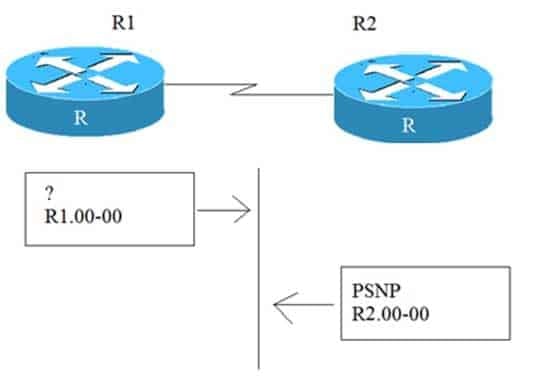
H12-261 HCIE-R&S (Written) (Huawei Certified Internetwork Expert-Routing & Switching) Part 11 Q011 038 - R1 sends a PSNP to R2
- R1 sends an LSP to R2
- R1 sends a Hello PDU to R2
- R1 sends a CSNP to R2
-
Which of the following statements regarding control are true?
- For node 10, the relationship between if-match community-filter 1 and if-match as-path-filter 1 is “AND.”
- Default OSPF, IS-IS, and BGP routes can be advertised.
- An AS-Path-filter filters routes based on the AS-Path attribute to affect route selection
- The import-route BGP command can be used to import IBGP routes
-
Both IS-IS and OSPF run on a network as shown in the following figure. Route import is configured on RTB and RTC respectively. All the routers are connected through GE interfaces. Routes to the network segment 2.2.2.2/32 is imported to the OSPF process using the import-route direct command on RTD. The default settings are retained for all the other configurations. Which of the following statements regarding this network is false?
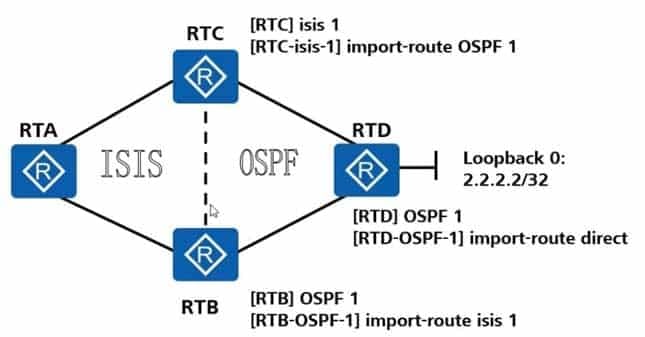
H12-261 HCIE-R&S (Written) (Huawei Certified Internetwork Expert-Routing & Switching) Part 11 Q13 039 - The following configuration can be performed on RTC to filter out only routes to the network segment 2.2.2.2/32 when RTC imports routes:
[RTC] ip ip-prefix 10 index 1 deny 2.0.0.0 8 less-equal 32
[RTC-isis-1]filter-policy ip-prefix 10 import - On RTB, adjust the IS-IS preference to 160 to avoid generation of sub-optimal routes on the network
- The following configuration can be performed on RTC to filter out routes from RTD to the network segment 2.2.2.2/32 when RTC imports OSPF routes:
[RTC-acl-basic-2001]rule 5 deny source 2.0.0.0 0.255.255.255
[RTC-acl-basic-2001]rule 10 permit
[RTC-isis-1]filter-policy 2001 import - RTB learns that RTA is the next hop of the route to the network segment 2.2.2.2/32
- The following configuration can be performed on RTC to filter out only routes to the network segment 2.2.2.2/32 when RTC imports routes:
-
The configurations of two routers in a company are shown. Which of the following statements regarding the routing table of R1 is true?
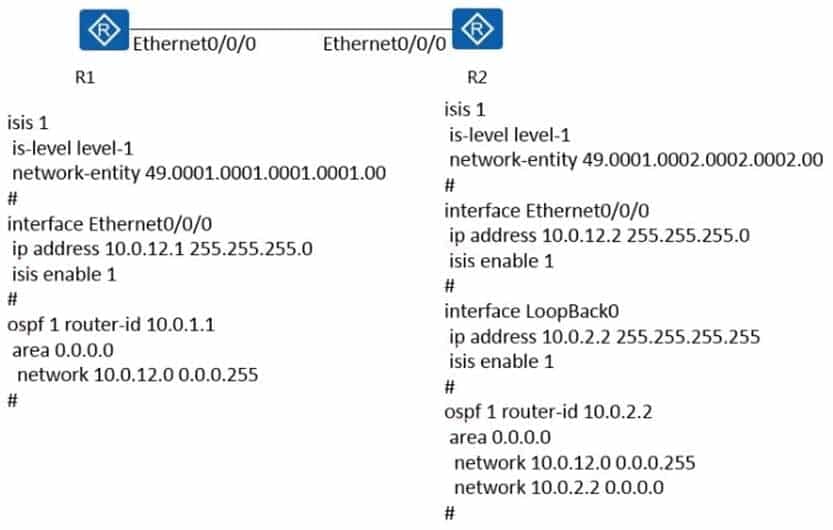
H12-261 HCIE-R&S (Written) (Huawei Certified Internetwork Expert-Routing & Switching) Part 11 Q14 040 - The IP routing entries whose destination network segment is 10.0.2.2/32 on R1 can be generated through OSPF only when the IS-IS preference of R2 is changed to 5
- If the IS-IS preference of R1 is changed of R1 is changed to 5, the IP routing entries whose destination network segment is 10.0.2.2/32 on R1 are generated through OSPF
- If the IS-IS preference of R1 is changed to 5, the IP routing entries whose destination network segment is 10.0.2.2/32 on R1 are generated through IS-IS
- If the IS-IS preference of R2 is changed to 5, the IP routing entries whose destination network segment is 10.0.2.2/32 on R1 are generated through IS-IS
-
Based on the scenario shown, which statement about R2 is true?
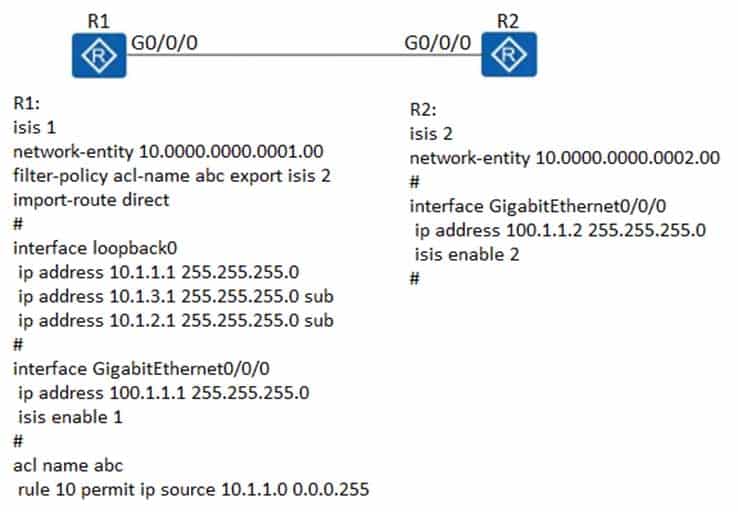
H12-261 HCIE-R&S (Written) (Huawei Certified Internetwork Expert-Routing & Switching) Part 11 Q15 041 - R2 can receive LSPs from R1, but cannot add the routing information in the LSPs to the routing table
- R2 can learn all routes advertised by R1
- R2 can learn only the route 10.1.1.0/24
- R2 can learn the routes 10.1.2.0/24 and 10.1.3.0/24
-
Policy-Based Routing (PBR) needs to be configured on a router to enable specified traffic to be forwarded through a specified interface. When PBR is used, which two types of information can be specified to enable traffic forwarding along a specific path?
- Type of Service and bandwidth usage
- Source IP address and specific protocol (such as FTP and HTTP)
- TTL and source IP address of packets
- Source IP address and Layer 2 source address
-
A router is connected to two EBGP peers through two parallel serial cables. What method can be used to achieve bidirectional load balancing between the EBGP peers?
- Run the ebgp-load-balance command on the EBGP peers.
- No method is needed. BGP automatically implements load balancing among different ASs through available links.
- Establish an EBGP peer relationship through loopback interfaces, and configure the loopback interfaces as update sources. In each AS, import two equal-cost routes to the loopback interface of each EBGP peer to the IGP process. In addition, run the ebgp-max-hop and next-hop-local commands.
- Configure an EBGP peer relationship through loopback interfaces, and configure the loopback interfaces as update sources. In each AS, enable two equal-cost routes to the loopback interface on each EBGP peer in the IGP process. In addition, run the next-hop-local command.
-
OSPFv3 and IS-IS are both running on a router, and the OSPFv3 routes need to be imported into IS-IS. Given this information, which of the following import configurations must be made?
-

H12-261 HCIE-R&S (Written) (Huawei Certified Internetwork Expert-Routing & Switching) Part 11 Q18 042 -

H12-261 HCIE-R&S (Written) (Huawei Certified Internetwork Expert-Routing & Switching) Part 11 Q18 043 -

H12-261 HCIE-R&S (Written) (Huawei Certified Internetwork Expert-Routing & Switching) Part 11 Q18 044 -
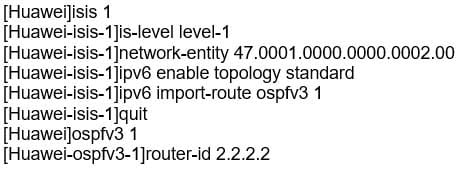
H12-261 HCIE-R&S (Written) (Huawei Certified Internetwork Expert-Routing & Switching) Part 11 Q18 045 -
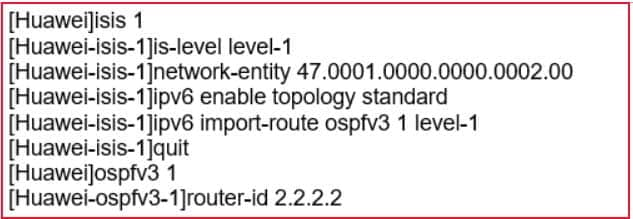
H12-261 HCIE-R&S (Written) (Huawei Certified Internetwork Expert-Routing & Switching) Part 11 Q18 046
-
-
Which of the following statements regarding the Multi-VPN-instance CE (MCE) is false?
- An MCE device creates a routing table for each VPN and binds each VPN instance to it’s interfaces
- The MCE has been bound to a VPN. Therefore, no VPN needs to be bound to the PE connected to the MCE
- Based on the interface for receiving routing information, the MCE determines the origin of the routing information and adds the routing information to the routing table of the corresponding VPN
- The MCE can connect to multiple VPNs. The MCE solution isolates services of different VPNs while reducing the cost of network devices
-
In the Hub-Spoke networking of MPLS BGP VPN shown in the figure below, users want to configure branches to communicate only with the headquarters but no other branches. To achieve this, which of the following solutions regarding RT settings can be used?
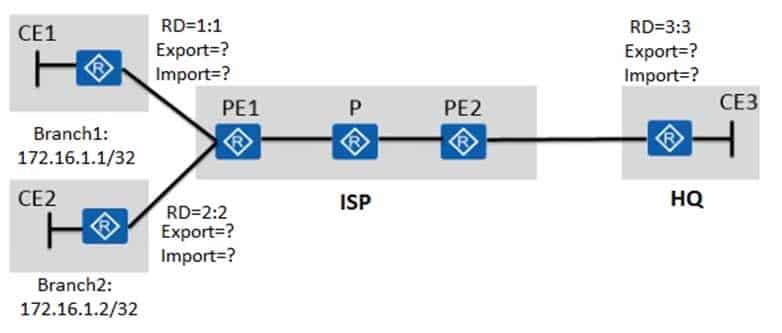
H12-261 HCIE-R&S (Written) (Huawei Certified Internetwork Expert-Routing & Switching) Part 11 Q20 047 - Headquarters: Import Target: 2:2; Export Target: 3:3
Branch 1: Import Target: 3:3; Export Target: 1:1
Branch 2: Import Target: 3:3; Export Target: 2:2 - Headquarters: Import Target: 12:3; Export Target: 3:12
Branch 1: Import Target: 3:12; Export Target: 12:3
Branch 2: Import Target: 3:12; Export Target: 12:3 - Headquarters: Import Target: 1:1; Export Target: 3:3
Branch 1: Import Target: 3:3; Export Target: 1:1
Branch 2: Import Target: 3:3; Export Target: 2:2 - Headquarters: Import Target: 12:3; Export Target: 12:3
Branch 1: Import Target: 12:3; Export Target: 12:3
Branch 2: Import Target: 12:3; Export Target: 12:3
- Headquarters: Import Target: 2:2; Export Target: 3:3
Subscribe
0 Comments
Newest